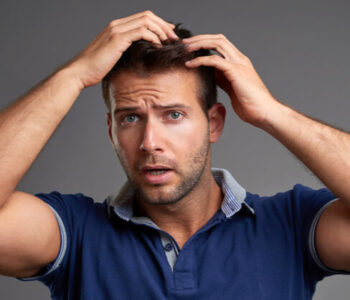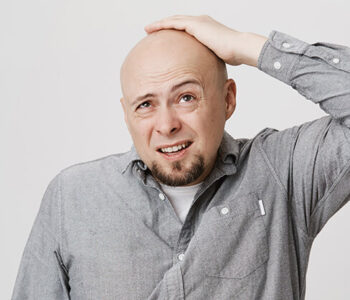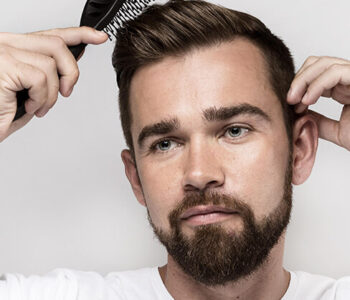In 30 seconds…
Finasteride is one of the most effective treatments for male pattern baldness on the market. Proven to halt – and even reverse – hair lo
Finasteride is one of the most effective treatments for male pattern baldness on the market. Proven to halt – and even reverse – hair loss in the majority of men, it is most commonly taken orally as a pill. However, that’s not the only way to enjoy its benefits.
What is topical Finasteride? While less well-known as a hair loss treatment than oral Finasteride, the topical treatment may well become a popular option for men with male pattern hair loss. It can be applied locally to the scalp and can be used in combination with other sprays, such as topical Minoxidil.
It works in the same way as the oral medicine, in that it blocks your body’s production of dihydrotestosterone, or DHT, the hormone responsible for hair loss in men and women. While topical application reduces the chances of Finasteride’s side effects, do bear in mind that the treatment is slightly less effective.
.
Androgenetic alopecia (AGA) – or male pattern baldness (MPB) – is the most common cause of hair loss in men. Estimated to affect 30% of us by the time we’re 30, the majority of us will probably experience it at some point in our lifetimes.
This does not mean, however, that it’s inevitable. Over the years, many different treatments for MPB have been discovered, with a range of different rates of success. Among these are two with the biggest proven effect on hair regrowth: Minoxidil – or Rogaine, as it is sometimes sold – and Finasteride.
In this article, we’re looking at a particular form of Finasteride. Rather than the more widely known oral Finasteride treatment, we’re talking about topical Finasteride – a Finasteride solution that is applied directly to your hair follicles. While not yet licensed as a treatment for MPB, results are very promising.
So, what is topical Finasteride – and does it work? Let’s take a look.
How Finasteride Works
If you’re familiar with the science of hair loss, you might know how Finasteride works already. Yet, for those who aren’t, let’s recap here. It all begins with a thing called DHT.
Dihydrotestosterone, or DHT, is the major enemy of hair growth in men. It’s a hormone that’s produced as a natural by-product of the breakdown of testosterone. While it is useful in your early years, for the development of your genitals, for example, it becomes less helpful as you age. One of its most frustrating effects is that it binds to your hair follicles and causes them to shrink, weaken, and, if left untreated, die.
However, there are medicines available that prevent this process from occurring. These are known as DHT blockers – and Finasteride is one of them.
What they do is prevent the production of DHT in the first place, by inhibiting the activity of the enzyme, 5alpha-Reductase, that is responsible for the conversion of testosterone. As a result of this 5α-Reductase inhibitor (Finasteride), both scalp skin and serum DHT levels can be reduced by up to 60%, according to a study published on PubMed.
And unlike the other, more invasive treatment of the androgenetic alopecia form of hair loss – such as a hair transplant – Finasteride tackles the cause at its root. Literally. You won’t just be just trying to hide a low hair density. Rather, in most cases, you’ll be actively increasing your hair count.
What is Topical Finasteride?
Most people take Finasteride, or Propecia, as a pill. However, it’s time we introduced the alternative: Finasteride’s topical solution. While not yet licensed by the US Food and Drug Administration (FDA), studies have shown that it is effective – and safe – in the treatment of MPB.
Like other medicinal solutions for hair loss – such as the Minoxidil solution – topical Finasteride is applied to the local area, i.e. the scalp, as a spray or lotion. While this makes the process of application slightly trickier than oral medication, it does mean that the effects are felt more locally.
This is particularly important for men who have tried oral Finasteride and have found themselves susceptible to side effects – whether dizziness, tenderness on the face, hands, and chest, or rashes. Meanwhile, while incredibly rare, more systemic side effects have occurred as a result of Finasteride too – including erectile dysfunction and difficulty reaching orgasm.
Topical Finasteride is thought to reduce the risk of these side effects, as the active agent does not enter into your wider system. Rather, it tackles DHT in a much more localised way – in exactly the place where the hormone causes problems.
Is Topical Finasteride Effective?
Topical Finasteride is an effective treatment for androgenic alopecia in those who are susceptible to side effects from oral use. And while not yet as common as its oral alternative, our knowledge of this novel treatment is continuing to grow.
One systematic review of topical Finasteride collated data from a number of different studies of the drug to assess its effectiveness. The majority showed that the drug was effective in over 70% of cases, while the risk of side effects was very minimal. Meanwhile, a 2020 review of over 28 different studies gave similarly promising results.
Importantly, topical Finasteride does not appear to be quite as effective as its oral alternative. Rather than stopping hair loss in 70% of cases, one study showed that oral Finasteride increased hair growth in 77% of male patients. Another study, meanwhile, put that number at 87%.
The Common Favourite: Oral Finasteride
There is a reason why Finasteride tablets remain the most popular option for the treatment of androgenetic alopecia. It’s easy, it’s effective in the vast majority of cases, and the risk of side effects is very low. By the FDA’s own figures, over the course of 23 years, only 400 people reported the serious sexual side effects of Finasteride. Another review, meanwhile, suggested that the link between oral Finasteride and serious side effects was not statistically significant.
However, it needn’t be a choice between one or the other. One study, published in a dermatology journal, looked into the possibility of a combination topical solution as a follow-up to oral Finasteride treatment. By mixing Minoxidil 5% and Finasteride 0.1%, it was found that nearly 85% of those involved maintained a hair density with which they were satisfied.

Works for 9/10 Men
The most effective oral treatment for receding hairlines and balding crowns. Just one pill a day.
Key Takeaways
Finasteride remains the most effective treatment for male pattern baldness on the market. And while you’ll hear a lot of noise about its possible side effects, scientific studies are increasingly suggesting that these are much less common than previously thought.
As a result, if you are just starting out with hair loss treatment, we would recommend you start with oral Finasteride. It’s safe and easy, it’s licensed for use, and it’s the most effective form of Finasteride treatment. However, every man is different – and topical Finasteride might be just what you’ve been looking for.












